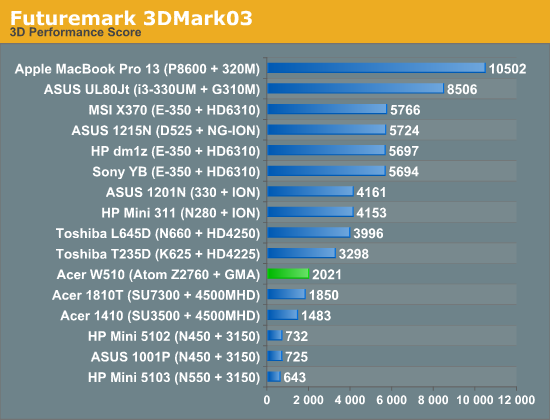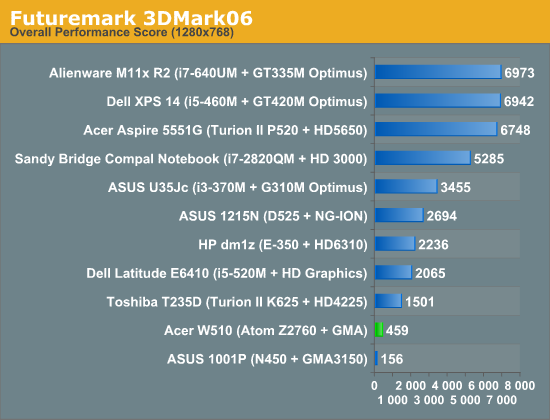The Clover Trail (Atom Z2760) Review: Acer's W510 Tested
by Anand Lal Shimpi on December 20, 2012 10:34 AM ESTGPU Performance
Contrary to popular opinion prior to its launch, the Clover Trail platform and Cloverview SoC feature a PowerVR SGX 545 GPU. The rumored PowerVR SGX 544MP2 won’t show up until Clover Trail+ next year. The SGX 545 is clocked at a fairly aggressive 533MHz.
Architecturally the 545 is very similar to the PowerVR SGX 540 used in Intel’s Medfield smartphone platform, with a handful of additions. The shader array remains unchanged at four USSE pipes. The 545 adds four more 10-bit integer pipes, doubles the triangle setup rate and doubles the number of depth test units as well. DirectX 10 class texture hardware is also a part of the mix, as well as everything else needed to officially support DirectX 10 (D3D feature level 9_3).
Compared to what’s shipping in the latest iPads however, Clover Trail is horribly under-specced. We don’t have good cross-platform (Windows RT/8) GPU tests yet, but based on what I’ve seen thus far it looks like the GPU here is a bit slower than what you get in a Tegra 3.
| Mobile SoC GPU Comparison | |||||||||||
| PowerVR SGX 545 | NVIDIA Tegra 3 | PowerVR SGX 543MP2 | PowerVR SGX 543MP4 | PowerVR SGX 554MP4 | |||||||
| Used In | Clover Trail | Tegra 3 | iPad 2/mini | iPad 3 | iPad 4 | ||||||
| SIMD Name | USSE | "core" | USSE2 | USSE2 | USSE2 | ||||||
| # of SIMDs | 4 | 12 | 8 | 16 | 32 | ||||||
| MADs per SIMD | 2 | 1 | 4 | 4 | 4 | ||||||
| Total MADs | 8 | 12 | 32 | 64 | 128 | ||||||
| GFLOPS @ 300MHz | 4.8 GFLOPS | 7.2 GFLOPS | 19.2 GFLOPS | 38.4 GFLOPS | 76.8 GFLOPS | ||||||
Looking at raw FP performance tells us a lot of the story. The 545’s high clock helps it punch above its weight, but it's still significantly less powerful than the 543MP2 used in the iPad 2/mini (and it’s nothing compared to what’s in the iPad 3/4).
Tegra 3-class GPU performance may have been acceptable a year ago running Android, but it’s just too little too late today. Since Clover Trail has full backwards compatibility with older Windows applications, I can put its GPU performance in perspective. Turning to 3DMark03 and 06, we can get a good idea of the class of performance we’re looking at. For complete (and consistent) comparison points, I've tossed the W510's results into Bench so you can compare to any notebook/mobile GPU you want to there.


Compared to the old Atom platform with Intel’s GMA 3150, the PowerVR SGX 545 based GMA is around 3x faster. Even Intel's old mobile G45 graphics are actually slightly slower. Performance is still far behind everything else modern though. The GPU is more than adequate for Modern UI acceleration, but if you have secret hopes of being able to run some of your older games on Clover Trail you’ll want to stash those dreams away.
None of this is really Imagination’s fault - Intel remains generations behind in implementing competitive GPUs in its ultra mobile SoCs. Even the jump to PowerVR SGX 544MP2 next year will happen just as Apple likely moves to Img’s Series 6 (Rogue) architecture. It’s definitely a problem if you’re a silicon company that delivers slower silicon than what your customers can put together.










104 Comments
View All Comments
popej - Thursday, December 20, 2012 - link
Could we get some comments how does it work as a tablet?Does Metro menu work efficient? Is on-screen keyboard usable? Has it sensors like accelerator, compass, GPS? Does it switch to portrait mode automatically? Any peculiarity with Metro in portrait mode? Is it usable outdoor? Is SD memory usable?
Thanks for review and benchmarks but I feel like I got more questions than answers ;)
mrdude - Thursday, December 20, 2012 - link
http://www.extremetech.com/mobile/141317-samsungs-...Supposedly the WiFi problems aren't restricted to the Acer W510 and Intel admitted there's an issue with the Samsung PC 500T.
Are these the same problems you're encountering? It sounds like some users have had similar issues as well.
That brand new Clover Trail SoC already looks dated :D Matches up nicely with the Tegra 3, but if I can buy a Google Nexus 7 for less than half the price of this Acer, and get better performance at that, it really shows just how out of touch both Intel and MS are in the mobile space where tablets are concerned.
bollux78 - Thursday, December 20, 2012 - link
Really, even if the performance is not very good, you can run anything, ANYTHING!Forget the tablets, I would not trade a x86 tablet in the present for an Ipad 15 coming from the future in a time traveler's bag with 30x more horsepower, unless you could run some virtual machine able to emulated a complete x86 machine. There is simply nothing to complain about this device.
kyuu - Thursday, December 20, 2012 - link
You do have a point, in that sure, the iPadWhatever has an impressive SoC, particularly the GPU. But... so what? What can you do with it? Play some "meh" mobile games?Still, I'd like to see an x86 Win8 tablet with something better than a rehashed Atom attached to a dismal GPU.
kyuu - Thursday, December 20, 2012 - link
I should add, I'd like to see that in a truly mobile tablet, not a big, battery-chugging monolith as the Surface Pro is likely to be (much as it may be appealing otherwise).dwade123 - Thursday, December 20, 2012 - link
Move aside ARM, Intel is coming through.DaveSimmons - Thursday, December 20, 2012 - link
Just like the steamroller in Austin Powers: very . . . . verrrry . . . . slowwwwllllyyyyDonkey2008 - Tuesday, December 25, 2012 - link
LOL. Absolutely perfect analogy.lopri - Thursday, December 20, 2012 - link
If the 64 GB version leaves you with 30 GB.. then how much space is left usable for the 32 GB version??kyuu - Thursday, December 20, 2012 - link
Negative 2 GB? o_0